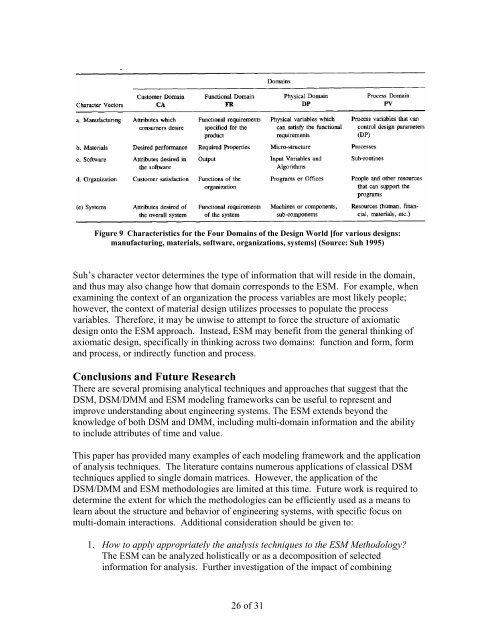Analysis and Applications of Design Structure Matrix, Domain ... - MIT
Analysis and Applications of Design Structure Matrix, Domain ... - MIT
Analysis and Applications of Design Structure Matrix, Domain ... - MIT
Create successful ePaper yourself
Turn your PDF publications into a flip-book with our unique Google optimized e-Paper software.
Figure 9 Characteristics for the Four <strong>Domain</strong>s <strong>of</strong> the <strong>Design</strong> World [for various designs:<br />
manufacturing, materials, s<strong>of</strong>tware, organizations, systems] (Source: Suh 1995)<br />
Suh’s character vector determines the type <strong>of</strong> information that will reside in the domain,<br />
<strong>and</strong> thus may also change how that domain corresponds to the ESM. For example, when<br />
examining the context <strong>of</strong> an organization the process variables are most likely people;<br />
however, the context <strong>of</strong> material design utilizes processes to populate the process<br />
variables. Therefore, it may be unwise to attempt to force the structure <strong>of</strong> axiomatic<br />
design onto the ESM approach. Instead, ESM may benefit from the general thinking <strong>of</strong><br />
axiomatic design, specifically in thinking across two domains: function <strong>and</strong> form, form<br />
<strong>and</strong> process, or indirectly function <strong>and</strong> process.<br />
Conclusions <strong>and</strong> Future Research<br />
There are several promising analytical techniques <strong>and</strong> approaches that suggest that the<br />
DSM, DSM/DMM <strong>and</strong> ESM modeling frameworks can be useful to represent <strong>and</strong><br />
improve underst<strong>and</strong>ing about engineering systems. The ESM extends beyond the<br />
knowledge <strong>of</strong> both DSM <strong>and</strong> DMM, including multi-domain information <strong>and</strong> the ability<br />
to include attributes <strong>of</strong> time <strong>and</strong> value.<br />
This paper has provided many examples <strong>of</strong> each modeling framework <strong>and</strong> the application<br />
<strong>of</strong> analysis techniques. The literature contains numerous applications <strong>of</strong> classical DSM<br />
techniques applied to single domain matrices. However, the application <strong>of</strong> the<br />
DSM/DMM <strong>and</strong> ESM methodologies are limited at this time. Future work is required to<br />
determine the extent for which the methodologies can be efficiently used as a means to<br />
learn about the structure <strong>and</strong> behavior <strong>of</strong> engineering systems, with specific focus on<br />
multi-domain interactions. Additional consideration should be given to:<br />
1. How to apply appropriately the analysis techniques to the ESM Methodology?<br />
The ESM can be analyzed holistically or as a decomposition <strong>of</strong> selected<br />
information for analysis. Further investigation <strong>of</strong> the impact <strong>of</strong> combining<br />
26 <strong>of</strong> 31

















